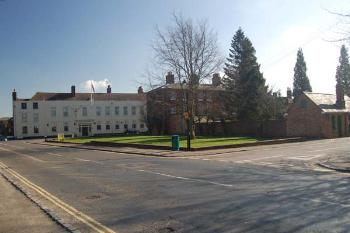The White Horse Inn Woburn

On the green space were, receding from the camera, The Swan, the White Horse and The Windmill with The Coach and Horses on the corner jutting out into George Street
The White Horse Inn: Leighton Street, Woburn
The White Horse is first mentioned in Sir Jonas Moore's survey of the Duke of Bedford's property in Woburn [ref: X1/33/1-3] which it shows it on the south side of Leighton Street. It is described as: "WHITEHORSE a large tyled howse five bay with back howse brew howse, barnes stables, Corne rooms, facing the markett, betwixt the last tenement and Richard Houghtons howse". The tenant was Edward Gale and it was copyhold, held from the Manor of Woburn Abbotts. Richard Houghton's house is the next entry in the survey and is described as "being the Corner howse at Duck lane next the white horse and faceth the markett". This property later became the Swan. This places the site of the White Horse on the area of grass between Duck Lane and the junction of Leighton Street and George Street.
The next document to mention the house is a court roll of 1693 in which John Gale surrendered the inn to Robert Geeves [ref: RBox237]. Next mention is in the register of parochial dues of 1709 to 1796 [ref: P119/3/1]. There are entries from 1712 to 1751 suggesting that it closed at about the latter date. The inn is mentioned in 1737 as abutting west onto the Swan and its yard being abutted north by three cottages which faced east onto George Street - at first glance this makes no sense but a glance at Thomas Evans' map (albeit of 1821) shows the reason - the middle premises between George Street and Duck Lane (i.e. the White Horse) was in an L-shape, the buildings fronting the Market Place to the north, the yard running south and turning a right angle to front George Street to the east; it has a row of cottages to the north of it and a corner building on George Street and Market Place north of the cottages; this latter building is the Coach and Horses public house. The Windmill seems to have stood between the Coach and Horses and the White Horse.
The tenants (owners of the copyhold from the manor) of the White Horse are listed in a summary of admissions to property held of the Manor of Woburn [X18/8]. In 1722 John Scarborough and Martha, his wife, were admitted. their rent was eightpence and they paid a £4 fine for admission. They were admitted again in 1742 as it was the custom of the manor that tenants were re-admitted after twenty one years. In 1749 and 1764 Henry Rock was admitted tenant. In 1779 Francis Moore was admitted and under this entry the clerk has written: "This was the White Horse rents afterwards slated at 2/-". Moore was re-admitted in 1786. Thomas Butler junior was admitted in 1789 amd in 1796 it was John Smith. Smith sold the property to the Lord of the Manor, the Duke of Bedford, in February 1800.
List of Licensees: note that this is not a complete list. Italics indicate licensees whose beginning and/or end dates are not known:
1661: Edward Gale;
1693: John Gale;
1693: Robert Geeves;
1712-1728: Benjamin Salt;
1731-1751: William Church.
List of sources at Bedfordshire Archives:
- X1/33/2: Mentioned in Sir Jonas Moore's Survey of Woburn Estate: 1661;
- RBox 237: Manorial Court Roll: 1693;
- P118/3/1: Parochial dues: 1709-1796 [1712-1751];
- QSR1727/62-63: Baggage of Queen's own Dragoons conveyed from inn: 1727
- R6/63/16/1: Abuts properties in a marriage settlement: 1737.